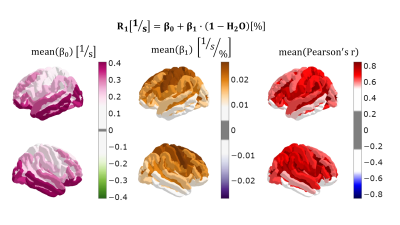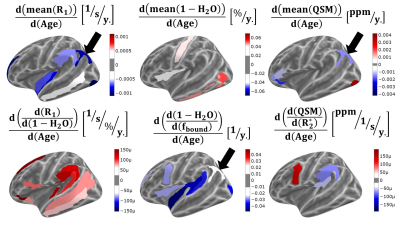Ana-Maria Oros-Peusquens*1, Jonas Kielmann*1, and N. Jon Shah1,2,3,4
1INM-4, Research Centre Juelich, Juelich, Germany, 2Faculty of Medicine, JARA, RWTH Aachen University, Aachen, Germany, 3INM-11, JARA, Research Centre Juelich, Juelich, Germany, 4Department of Neurology, RWTH Aachen University, Aachen, Germany
1INM-4, Research Centre Juelich, Juelich, Germany, 2Faculty of Medicine, JARA, RWTH Aachen University, Aachen, Germany, 3INM-11, JARA, Research Centre Juelich, Juelich, Germany, 4Department of Neurology, RWTH Aachen University, Aachen, Germany
Changes of quantitative
parameters and of their correlations in healthy aging are detected and
interpreted.

Fig1: Cortical variation of the correlation between
the complement of water content (macromolecular content) and R1,
described in a linear model with coefficients beta0 and beta1, and by Pearson’s
correlation coefficient.
We mention that R1 and 1/H2O show a nearly identical correlation to R1 and
(1-H2O), although the physical models behind the two dependencies are very
different [14] (data not shown). The sensorimotor areas, known to have high
myelination, show strong correlation with (1-H2O) (large beta1 and r),
accounting for practically all the relaxation rate (small beta0).

